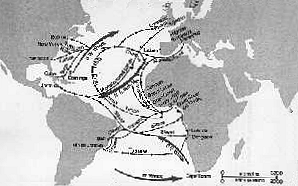Bristol
and
Slavery
The Transatlantic Trade Triangle
When the monopoly of the London-based Royal Africa Company came to an end in 1698, Bristol found itself well placed to enter the "Africa Trade" and by 1730 had replaced London as the centre of operations for the slave trade.
...the greatest, richest and best port of the trade in Great Britain, London only excepted. The merchants of this city not only have the greatest trade, but they trade with a more entire independency upon London, than any other town in Britain.
...the Bristol merchants as they have a great trade abroad, so they have always buyers at home, for their returns and that such buyers that no cargo is too big for them.
A description of Bristol by Daniel Defoe: "Tour Through England and Wales" c.1720
Bristol's location on the Atlantic side of Britain also aided its participation in the slave trade.
Bristol in the 18th Century
For outwardly respectable merchants "out of sight was out of mind"; their lust for money overcame any doubts they may have had about the moral legitimacy of the trade. Amongst the leading Bristol merchants of the time who benefited substantially from the slave trade were John Pinney and Edward Colston.
But how exactly did the trade operate?
The trading in slaves revolved around three separate strands of a complete voyage:
The complete round trip took about 12 months and the conditions on board were hard and dangerous. Many captains of slave ships (or 'blackbirds' as they were sometimes called) had a reputation for cruelty, and both crew and African slaves suffered.

